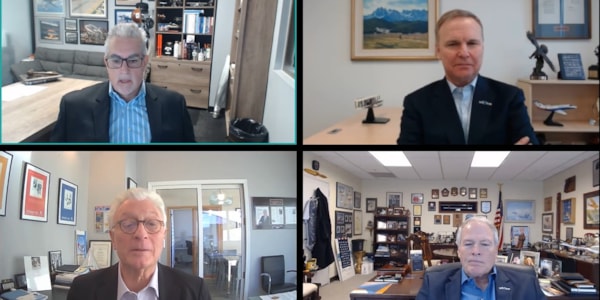FAA inefficiencies a hot topic in discussion among private aviation leaders

With bureaucratic challenges in the FAA, the industry is struggling with the resulting inefficiencies, according to a group of private aviation leaders that spoke in a panel Thursday.
In the NBAA-hosted webinar, NBAA News Hour, leaders in the industry discussed the various issues within the FAA, a lack of a voice and proper communication for aviation amongst the public and government, increasing awareness on safety and sustainability, and the strong need to get ahead of an emerging electric market.
The Business Aviation Industry- From the Top Down featured industry leaders from GAMA, NATA and the NBAA. President and CEO of Mesinger Jet Sales Jay Mesinger was the moderator and was joined by President and CEO of the NBAA Ed Bolen, President and CEO of GAMA Peter Bunce, and President and CEO of NATA Curt Castagna, C.M.
Bunce has been the GAMA President since 2005, representing an important segment of the industry. Mesinger asked about the challenges he has faced working with the FAA and what challenges his constituents find.
Bunce said 2022 was a tremendous year, between record sales and numbers and the modernization of aircraft. He said as the ramp-up is leading to a possible recession, there has been an “artificial constraint” in the industry. Many people are waiting long periods for parts and there is increased difficulty in filling jobs and positions. He said this has not allowed the industry to ramp up as heavily, which could protect the industry in the wake of a recession.
Bunce said what concerns him the most is the regulatory environment.

Pete Bunce
“If you look at what we want to do from a technology standpoint, that allows us to meet these sustainability goals that we have, but also the safety goals that we have, right now the bureaucracy that exists within the FAA is debilitating,” he said.
He said it is not an issue of the people involved.
“40 percent of the certification workforce in the FAA have less than two years of experience.”
He said, to add to this many work from home. With many older figureheads retiring, the new workforce that will replace them is inexperienced and does not have the access needed for on-site training. He said there is a big difference between the current workplace environment and the traditional face-to-face workplace from before the pandemic.
He said that now the existing structure of the FAA, there are many issue papers and special conditions that could have been condensed into a single rule. Bunce said this was seriously impacting the efficiency of the agency. The combination of a new workforce, old technology and a lack of efficiency is hindering the industry.

FAA Acting Administrator Billy Nolen
Bunce said the bureaucratic situation is causing a serious delay in new technology and the pace toward sustainable aviation. He said things have to change and there is an illusion that a permanent FAA leader will change everything. He said even with a stable and permanent FAA administrator, change will not come easy.
When talking to Congress this year, the panel will suggest a 90-day review of processes of what has to go through FAA legal and what has to go through the DOT.
Bolen also discussed the challenges with recent and current legislation and having a voice on Capitol Hill. He said they had been given a tax credit, had legislation to improve advanced air mobility, improved infrastructure, and even more at the grassroots level, like ensuring helicopters could still fly in New York.
Bolen said that power is when the people in the community let their voices be heard. He said legislation impacts all of us and all voices are important to improve and change what is being legislated for the industry.

The current FAA Authority to Act will expire on Oct. 1. Efforts will be made to pass a new act and noted that hearings begin next week on the FAA Reauthorization Act. Bolen said the industry needs to work together, clearly promoting safety and the workforce. With debates on things like the debt ceiling and possible government shutdown, the industry needs to ensure the FAA can still properly function and support aviation.
Castagna said it was important to have leadership at the FAA level. On a daily basis, teams interact with middle management and staffers at the FAA level, building relationships and enhancing support. It is important to bring in the necessary resources, skills and staff to promote this effort.
Mesinger asked Bolen if he was optimistic about that leadership. Bolen said many of those placed in acting leadership roles are now becoming permanent. He said we want strong leadership and continuity in the organization. At all levels, they want to attract good people with a thorough understanding and appreciation of the industry.
With a global marketplace and new technology and innovation coming in all around, Bolen said it is important for the U.S. to lead. With changing technology and modernizing aircraft, it is not a question of if, but when.
RELATED STORIES:
Pyka unveils Pelican Cargo, first autonomous electric zero-emission cargo airplane
Pre-registration for first Pulitzer Electric Aircraft Race open
Mesinger asked the panel about the impact the rise of electric aircraft will have on each of them and their roles in the industry.
Bunce noted that the recent changes are meant to provide a thought process to provide for the changing infrastructure. He said everyone knows that the influx of electric aircraft is coming. Research is being done on the electrification of larger aircraft in the future, including hybrid solutions burning SAF or using hydrogen power.
“There is great promise out there,” Bunce said.
The industry is in an exciting time, learning to use electric aircraft and find different resources, fuels and technologies to function in a new society.
RELATED STORIES:
WATCH: ZeroAvia flies Dornier 228 with hydrogen-powered engine
Rolls-Royce tests mtu engine with pure hydrogen fuel
Bunce said he and Bolen recently visited the White House, and they explained the amount of investment across the world into the new type of electric propulsion. The panel members pushed the electric movement to stay ahead of the global market and industry.
Bolen said as a whole, the government needs to facilitate these new technologies to get ahead of the transition. Groups like the department of energy, homeland security, the defense department and smaller organizations and institutions like airports. There was an emphasis on ground electric vehicles, but there needs to also be a focus on bringing this type of propulsion to aviation.
Castagna said the many components of the industry need to work together on the changes and stay ahead of other countries.

He referenced a story he heard about when the wright brothers came out, if they had been overregulated, we would have never ended up on the moon.
Bunce said after the Wright brothers, the U.S. did not embrace their ideas. They went to Europe and when WWI came, the U.S. had to turn to Europe for aircraft. He said we need to prevent this with the electric aircraft surge and keep the U.S. involved in the mass use of SAF and sustainable electric aircraft, especially with the upcoming 2028 Olympics in Los Angeles.
The industry is continuing to work toward a sustainable goal, but finds challenges with government regulations and protests from environmental agencies, threatening to halt the progress that requires a transition from traditional methods to a new sustainable method.
RELATED STORY:
GA public response to EPA on leaded fuel
Castagna discussed fuel changes, like the removal of lead from traditional fuels. He said the general aviation industry is aligned in the wish to remove the lead and doing so in a rational process to remove lead-based fuel safely. He said what they are opposed to is the pressure from the public and legislation to outright ban the current fuel in advance of a replacement, feeling that is not a safe transition for the industry. He said they are in support of EAGLE, but feel working together can achieve the goal in advance of 2030.
Bunce said that business aviation is under attack in Europe. There is a huge difference in the U.S., as we exist without the rail infrastructure that is in Europe and we rely on aviation as a mode of transportation. He said we need to get ahead of the discussion and encourage ideas to bring to other organizations in Europe.
“Those same types of arguments migrate this way,” Bunce said.

Environmental protests went on around the world, calling for a ban on private jets
Castagna added it is important to educate the environmentalist groups and government on the process and rational way to transition sustainability into an industry that is necessary for this country to function.
Bolen highlighted the efforts of the industry in sustainable aviation and the movement toward the goal of net-zero emissions by 2050. This includes SAF, making sure it is available, affordable and scalable.
The industry has dealt with shortages, in both supply and the workforce.
With about 40 years in the industry, Castagna discussed his view on FBO and MRO operations. He discussed workforce development and various roles within the industry, roles outside of pilots, like architects, mechanics and other important roles in the field. He said it is a challenge, from the federal government to airports and FBOs. Looking forward, there is a focus on looking beyond traditional talent and ways outside of the industry to build and grow talent and ideas.
RELATED STORY:
ALPA uses FAA numbers to challenge the notion of a pilot shortage
The pandemic changed the industry as a whole, adding an influx of new buyers and changing how people fly.
Mesinger asked Castagna his thoughts on Part 380 picking up speed. He said it is not a new phenomenon, it is an established regulation. It allows the arrangement for a part 380 operator to fly a part 135 or scheduled 135. With the shift from urban to remote living, there was a rise in the requirement for air transportation in new areas and a new market.
He said business and general aviation are now playing a role that differs from the post 9/11 world, changing with the pandemic and how aviation has evolved since. He said new communities are seeing different activity levels than seen before. Castagna said the two fields in aviation have taken some of the traffic from commercial aviation.
Mesinger asked Bolen about first-time buyers and the influx of individuals new to the industry flooding in since the pandemic. Bolen said the industry was not designed for the rate of growth we have seen in recent years. He asked if the NBAA was assisting the new flyers and buyers through programs or information and providing visibility to this new demographic in the industry and community.
.jpg?w=800)
NBAA 2023 Schedulers & Dispatchers Conference broke attendance records
With the return of face-to-face interaction, conventions have returned in full swing. Mesinger asked Bolen to share his thoughts on the opportunity for face-to-face interactions, like the recent record-breaking SDC conference.
“Business aviation has always been about facilitating face-to-face communications,” Bolen said.
Bolen said much of business is reliant on connection and that the return to real face-to-face interaction proves how the community cares for and builds relationships with one another.
Mesinger also commended the NBAA on its commitment and initiatives to diversity and inclusion. Bolen said that for the industry to reach its potential, as a whole “we need to attract and to develop and retain, the best and the brightest.”
Bolen said these “best and brightest” could be in communities unaware of the opportunities within the industry. It is important to work on outreach in grade school, high school and college to help people understand that there are many different jobs in aviation, from engineering to graphic design.
He noted that events that include a diverse group of individuals, like keynote speakers that are representative of every community, can reach more people.
RELATED STORIES:
Illegal charter identification program created, internal process reports suspected operations
Air Charter Association bring awareness to illegal charter flights with ‘Fly Legal Day’ to honor late footballer
Mesinger asked the panel about the rise in illegal operations like illegal charter companies. Castagna said, from NATA’s perspective, they endorse legal chartering and want to maximize legal charter operations. He said they look to the FAA as being responsible for identifying and managing illegal operations. He said their focus was the structure for endorsing legal chartering and ensuring the community inside and outside the industry can identify illegal practices.
“It’s not a punishment issue, it’s a corrective issue,” Castagna said.
“Right. It’s an education piece,” Mesinger said.
With a changing market and new buyers flooding the industry, there needs to be a focus on educating about safety.
RELATED STORIES:
ACSF reviews FAA proposed SMS rule, will submit comments before deadline
FAA proposes mandated SMS program, public feedback requested
Bolen discussed the importance of safety to close out the webinar. He discussed changes to be aware of, like the recent FAA SMS notice to the proposed rulemaking, which the industry is digesting. The industry as a whole needs to continue to make comments and use their voices not just on Capitol Hill, but with the executive branch as well.
“Safety is the foundation of general aviation and business aviation,” Bolen said.
Contact
Name: Haley Davoren
, Digital Content Manager
Company: GlobalAir.com
Website: https://globalair.com
Email: [email protected]
Phone: 502-456-3934
©2023 GlobalAir.com, Haley Davoren. All rights reserved.



Recent Comments